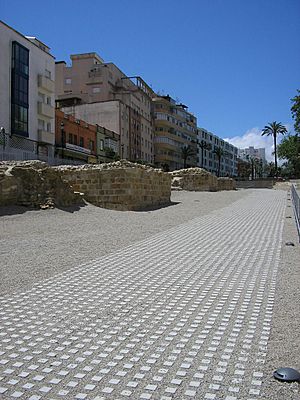Marinid Walls of Algeciras facts for kids
Quick facts for kids Marinid Walls of Algeciras |
|
|---|---|
| Native name Spanish: Parque Arqueológico de las Murallas Meriníes de Algeciras |
|
 |
|
| Location | Algeciras, Spain |
| Official name: Parque Arqueológico de las Murallas Meriníes de Algeciras | |
| Type | Non-movable |
| Criteria | Monument |
| Designated | 1985 |
| Reference no. | RI-51-0012209 |
| Lua error in Module:Location_map at line 420: attempt to index field 'wikibase' (a nil value). | |
The Marinid Walls of Algeciras are ancient city walls found in Algeciras, Spain. These walls are a very important historical site. Because of their importance, they were officially named a Bien de Interés Cultural in 1985. This means they are a protected cultural heritage site in Spain.
History of the Walls
Figuring out the exact age of these walls has been a bit tricky for historians. At first, people thought they were built by the Marinids. This was a powerful group from North Africa in the late 1200s.
However, new discoveries in 2012 changed this idea. Experts found old writings and clues that suggest something different. The oldest parts of the walls might be from before 1342. But a lot of the walls were rebuilt and changed by the Castilians. This happened between 1344 and 1350.
The Castilians rebuilt the walls after they won the Siege of Algeciras. The walls were badly damaged during this long battle. Later, in 1369, the Nasrids of Granada took over the city. They tore down the walls. They also removed any signs or writings that showed the Castilians had been there.
The Gibraltar Gate
Part of the walls that still remains is a gate. It is known as the Puerta de Gibraltar. This means the "Gibraltar Gate." It is also sometimes called the Puerta del Fonsario.
When the Castilian builders fixed this gate, they mostly followed its original design. They built square towers. These towers were common in the Islamic building style of that time.
There was also a bridge leading to the gate. This bridge crossed a moat, which was a ditch filled with water for defense. The sides of the bridge have special decorations. They show circles that are linked together. This pattern is called a Mudéjar design. You can see a similar pattern in the Courtyard of the Maidens. This courtyard is part of the Alcázar of Seville, a famous palace built in the 1300s.
See also
 In Spanish: Parque Arqueológico de las Murallas Meriníes de Algeciras para niños
In Spanish: Parque Arqueológico de las Murallas Meriníes de Algeciras para niños

